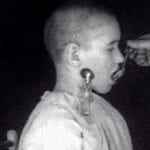 Animals
Animals  Animals
Animals  Weird Stuff
Weird Stuff 10 Weird Things People Used to Do at New Year’s
 Our World
Our World 10 Archaeological Discoveries of 2025 That Refined History
 Weird Stuff
Weird Stuff 10 Fascinating Facts You Might Not Know About Snow
 Miscellaneous
Miscellaneous Top 10 Things Crypto Was Supposed to Change & What Actually Did
 History
History 10 Huge Historical Events That Happened on Christmas Eve
 Music
Music 10 Surprising Origin Stories of Your Favorite Holiday Songs
 History
History 10 Less Than Jolly Events That Occurred on December 25
 Weird Stuff
Weird Stuff 10 Funny Ways That Researchers Overthink Christmas
 Politics
Politics 10 Political Scandals That Sent Crowds Into the Streets
 Animals
Animals 10 Species That Refused to Go Extinct
 Weird Stuff
Weird Stuff 10 Weird Things People Used to Do at New Year’s
 Our World
Our World 10 Archaeological Discoveries of 2025 That Refined History
Who's Behind Listverse?

Jamie Frater
Head Editor
Jamie founded Listverse due to an insatiable desire to share fascinating, obscure, and bizarre facts. He has been a guest speaker on numerous national radio and television stations and is a five time published author.
More About Us Weird Stuff
Weird Stuff 10 Fascinating Facts You Might Not Know About Snow
 Miscellaneous
Miscellaneous Top 10 Things Crypto Was Supposed to Change & What Actually Did
 History
History 10 Huge Historical Events That Happened on Christmas Eve
 Music
Music 10 Surprising Origin Stories of Your Favorite Holiday Songs
 History
History 10 Less Than Jolly Events That Occurred on December 25
 Weird Stuff
Weird Stuff 10 Funny Ways That Researchers Overthink Christmas
 Politics
Politics 10 Political Scandals That Sent Crowds Into the Streets
10 Medical Conditions Associated With Horror Movie Characters
When extreme medical conditions are unfamiliar to the general public, these illnesses and disorders may seem especially strange. Horror movies, which, in general, have seldom been known for their sensitivity concerning such conditions, sometimes exploit movie patrons’ fear of, and fascination with, such maladies, basing the victims, villains, or other characters on the afflictions real men and women sometimes suffered.
Today, people are better-educated about these physical and mental health problems and are much less inclined to view those who suffer from them as helpless, pitiful, menacing, or evil. Nevertheless, audiences continue to pay to see movies featuring unusual physical and mental disabilities, as these ten medical conditions that inspired horror movie victims and villains suggest.
10 Acromegaly
In The Brute Man (1946), Rondo Hatton (1894–1946) plays a disfigured man, Hal Moffat, who’s known to police as “The Creeper.” Hell-bent on avenging himself for his disfigurement, Moffat murders Professor Cushman and Clifford Scott, who he blames for his condition.
Hatton had acromegaly, a hormonal disorder caused by the pituitary gland’s excessive production of growth hormone during adulthood. The condition results in enlarged bones in the hands, feet, and face, although the effects of the disorder are gradual, sometimes taking years to become noticeable. Untreated, acromegaly can cause a number of relatively serious complications. Today, it responds to drugs, radiation, and surgery.[1]
9 Capgras
The victim of Goodnight Mommy (2015) is a bandaged woman (Susanne Wuest). She comes home after plastic surgery, claiming to be the mother of twins Lukas (Lukas Schwarz) and Elias (Elias Schwarz). The boys aren’t sure she is who she claims to be. Her behavior is bizarre. She tells Elias that Lukas died in an accident prior to her return home. Elias doesn’t believe her. He burns the house down, and the woman perishes in the fire. As Elias walks through a cornfield, he’s reunited with Lukas and his mother. Are they Elias’s hallucinations, just as the bandaged woman told him? Was she actually his mother, as she’d claimed to be? Did Elias die in the fire with her? Is he now a ghost, reunited with the spirits of his dead mother and brother?
Elias’s behavior is based on Capgras, which may occur in people with psychosis or schizophrenia, injuries or diseases of the brain, Alzheimer’s, or other forms of dementia. The condition’s cause is unknown, but the syndrome’s marked by “a total inability to recognize previously familiar faces” or by facial recognition that results in “disagreement about the person’s true identity.” The syndrome can be dangerous, especially if “imposters” are regarded as evil. Some victims of those with the Capgras delusion have been injured or killed.[2]
8 Cherubism
The actor Robert Z’Dar (born Robert J. Zdarsky) had a medical condition known as cherubism, the distinguishing characteristic of which is an exceptionally large chin and jawline. Z’Dar’s appearance helped the 188-centimeter-tall (6’2″) actor land roles in horror movies and other films, often playing a menacing villain. Z’Dar died in 2015 at age 64, but he was in demand right up to his demise.[3]
One of the roles for which Z’Dar is best known is that of The Angel of Death in the horror movie Soultaker (1990). He oversees the title character, a mysterious figure who collects the souls of the dead as punishment for having murdered his wife. After ex-lovers Natalie and Zack Taylor are killed in a traffic accident, their souls are trapped in limbo. The Angel of Death orders Soultaker to locate them and collect their souls. Natalie, who looks like Soultaker’s wife, tricks him into allowing Zack and her to escape. Soultaker reports his failure to the unforgiving Angel of Death.
7 Epilepsy
After being diagnosed with grand mal epilepsy in 1968, Anneliese Michel (1952–1976) started to see “devilish grimaces” while praying. She came to believe she was a victim of demonic possession. Her behavior became increasingly bizarre. She beat and bit family members, refused food, “slept on the stone floor, ate spiders, flies, and coal,” drank her own urine, screamed for hours, broke crucifixes, destroyed paintings of Jesus, pulled rosaries apart, mutilated herself, tore her clothes off, and urinated on the floor.
After first denying Father Ernst Alt’s request for permission to perform an exorcism, the bishop of Wurzburg, Josef Stangl, authorized Alt and Father Arnold Renz to do so. The priests performed the rite for months, but Michel’s condition never improved, and she died at noon on July 1, 1976. Her parents and the exorcists were accused of “negligent homicide” when it was found that Michel had starved to death, having refused to eat.
At trial, psychiatrists testified that Michel suffered from epilepsy and said her belief that she was possessed by demons was due to the statements and influence of the exorcists and her parents, who told her such things. The defendants, who were convicted of “manslaughter resulting from negligence and omitting first aid,” were sentenced to six months in jail and probation. Videotaped images of Michel during an exorcism shows her emaciated, with black eyes and discolorations on her face.[4]
The Exorcism of Emily Rose (2005), in which Jennifer Carpenter appears in the title role, dramatizes the account of these events, asking viewers to decide for themselves whether they believe Rose’s behavior should be attributed to epilepsy or demonic possession. Did Emily die because medical treatment and drug therapy were withheld from her or because the demons possessing her killed her?
6 Hydrophobia
Although the word “hydrophobia” is often considered a synonym for rabies, it simply means “fear of water,” and it is in this sense that it’s used in the 2014 horror movie The Drownsman. A young woman named Madison (Michelle Mylett) develops hydrophobia after she almost drowns in a lake. She isolates herself from the world but is soon haunted by a mysterious figure. Seeking to help after watching Madison suffer from her visions and fears for a year, four friends investigate the entity, only to be “dragged [ . . . ] to a horrifying place” from which there’s no return.
Hydrophobia can manifest itself as a fear “of drowning or being submerged,” even in small amounts of water, avoidance of all bodies of water and most liquids, and maintaining a distance from sources of liquids, including sinks and showers. Although hydrophobia results from rabies, it can also develop gradually as a fear of entering the ocean or another body of water and intensify as it becomes more generalized over a period of time.[5]
5 Hypohidrotic Ectodermal Dysplasia
In The Hills Have Eyes (1977), mutant cannibal killers attack lost tourists traveling through a remote area of the Nevada desert. One of the cannibal killers is Pluto, played by Michael Berryman, whose unique physical appearance is due to hypohidrotic ectodermal dysplasia.
The condition is a rare inherited multisystem disorder characterized by an absence of sweat glands, hypotrichosis (little hair), malformed teeth, “a prominent forehead, a sunken nasal bridge, unusually thick lips, and/or a large chin,” thin skin, a lack of pigmentation, premature aging, and other anatomical and physiological deficiencies. A variety of such symptoms occur in different individuals, and treatment of the condition depends on which characteristics are present in a particular person.[6]
4 Kyphosis
Charles Laughton appears as the “hunchback” Quasimodo in The Hunchback of Notre Dame (1939). Quasimodo is forced to live in isolation inside the Notre Dame Cathedral under the guardianship of Frollo, the king’s high justice. Frollo has accused Esmeralda of killing her fiance, the poet Gringire, and of bewitching Frollo himself. She is sentenced to death, but Quasimodo rescues her, later saving her life again by throwing Frollo to his death from the cathedral’s bell tower.
Quasimodo’s condition is caused by kyphosis, a pronounced “forward rounding of the back.” The condition can occur in older people, especially women, due to osteoporosis, which weakens the bones of the spine until they crack and compress. It can also occur in infants due to spinal malformation or in teens because of a “wedging of the spine over time.” Other causes of kyphosis include disk degeneration, Scheuermann’s disease, birth defects, cancer, and cancer treatments. Although the movie doesn’t explain the cause of Quasimodo’s kyphosis, severe cases of the condition, such as his, can cause pain and disfigurement. Today, kyphosis is treated with drugs, therapy, and surgery.[7]
3 Dwarfism
The controversial horror movie Freaks (1932) involves the the beautiful former aerialist Cleopatra’s seduction of a dwarf named Hans, who’s inherited a lot of money. Cleopatra conspires with the circus strongman Hercules to murder Hans after she’s married him, but their plan is thwarted by the other freaks, who are united by the “code of honor” they share. The cast included actual sideshow performers, but the public’s response to the movie was disastrous, and MGM spent the next three decades doing everything they could to distance themselves from the project.
A dwarf is defined as any full-grown adult who is 147 centimeters (4’10”) or less. Dwarfism is caused by either genetics or a medical condition. Most cases result from a random genetic mutation in the DNA from either parent. Other causes include growth hormone deficiency and poor nutrition. Hormone therapy, surgery, lifestyle accommodations, and emotional support are used to address symptoms associated with the condition.[8]
2 Paraplegia
In Kongo (1932), a remake of West of Zanzibar (1928), a wheelchair-bound paraplegic white man posing as a “living god” rules an African area, exploiting the indigenous people’s superstitious beliefs through “stage magic” and subduing the few other white people who live in his domain through sadistic measures.
Paraplegia is caused by the occurrence of a spinal cord injury “below the first thoracic spinal nerve.” As a result of such injury, the legs lose feeling and some degree of movement. Paraplegia can be complicated by skin care problems and by losses of bladder or bowel control and sensory or motor function. Short-term treatment seeks to recover as much function as possible, while long-term treatment focuses on compensation for the effects of the condition and avoiding complications.[9]
1 Photosensitivity
In The Others (2001), Grace Stewart and her children, Anne and Nicholas, have taken refuge in a Channel Islands mansion during the end of World War II, awaiting the return of their husband and father, who’s on his way home from the front lines. Anne and Nicholas have photosensitivity, an extreme allergy to sunlight. To prevent them from developing sores or having their throats “close up,” the windows’ heavy curtains must be kept drawn at all times. After the arrival of a mysterious trio of servants, Grace begins to suspect her house is haunted by possibly malevolent ghosts. As it turns out, she’s half-right: The mansion is haunted—but not by the ghosts she imagines.
Photosensitivity results from “an immune system reaction to sunlight.” Most often, it produces a red rash on the “ ‘V’ of the neck, or on the back of the hands, arms, or calves.” More severe reactions include the development of hives and blisters or a spreading of the reaction to skin covered by clothes.
The treatment for photosensitivity, as The Others suggests, is avoiding sunlight by wearing protective clothing, using sunscreens, and discontinuing the use of drugs that cause photosensitivity.[10]
Leigh Paul enjoys reading and writing, but she’s not crazy about arithmetic.
Read more about inspirations for horror movies on 10 Inspirations For Top-Grossing Horror Movies and 10 Horrific Inspirations For Terrifying Horror Movies.








